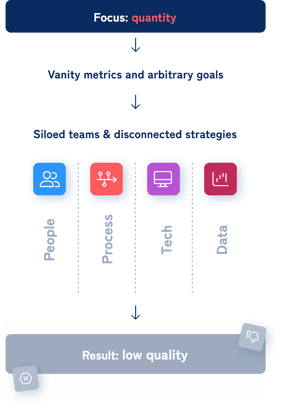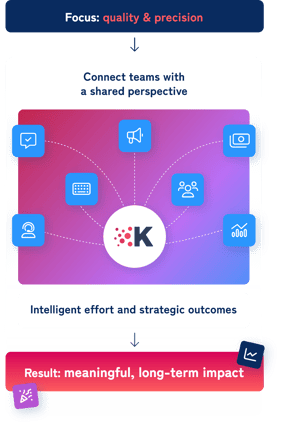One of the most helpful things I learned in a managerial accounting course is that goals dictate a team’s activity.There are countless headlines across different industries that share how organizations prioritize large goals yet still come away with unfavorable outcomes—inflated, short-term sales gains, big layoffs, and more.
Desiring huge revenue gains alone can be perceived as greedy and self-serving. As a customer, it feels bad knowing everything is transactional - that we're a quota that needs to be met. It can feel like our circumstances don’t matter and that our specific concerns are overlooked.
Instead, imagine if you talked about your revenue goals through the lens of how you're serving your customers and the broader market by investing your time and energy in building capabilities to serve them well.
Unfortunately, many revenue teams continue to be focused on quantity alone. This often leads to vanity metrics and arbitrary goals where it’s easy to go astray. While the goal may be clear, it can feel like the manner teams have to approach this work lacks clarity on how to get it done.

When the focus is on quanitity, the work is tackled by individual owners or smaller pods, motivated to hit their own targets. In creating and tackling tasks, people get more easily siloed away using processes, tools, and data in a way that disconnects them from the whole, instead of tackling the goal in more efficient and effective ways.
Results are often low-quality production and ultimately a team unfocused on creating a great customer experience, regardless of who is interacting with the customer or prospect.
The way to success
But “more” doesn’t have to be a dirty word and, in fact, can be a helpful goal when paired with qualifiers. Quantity and quality don’t have to be at odds. Goals and measures prioritize supporting the right prospects along the customer journey. When teams balance both quantity with quality and precision, hitting higher goals looks different in the way the work is tackled and how it's received by customers.

Teams are encouraged to work together from a common foundation, understanding what’s happening on the whole and, as needed, in each individual account that they’re serving or supporting. This is done through pursuing a common goal so that everyone knows the direction and a shared data foundation that is pulling in information across the different platforms that teams are using to communicate with prospects, customers, and each other.
Process, technology, and data are there to support the people no matter what their role is on the go-to-market team. The Product team can prioritize feedback that is supporting the rallying cry of the company. Customer Success has more information to be proactive with current customers with the right information. Sales and Marketing can prioritize targeting based on where they can make the most impact, forgoing interactions that don’t make sense for the business.
With support from the data, teams can even rely on notifications to help them continue to prioritize the who, what, and why. Early alerts can promote proactive activities as accounts trend towards less engagement or teams fall back on typical outreach patterns. Additional messages can provide everyone with perspective to coordinate on top priorities and deliver the right offering as needed.
The results are worth it: a happier customer who gets a better, more tailored experience; a better communicating and coordinated team; work with more meaningful, lasting impact.
To learn more about how to get these results from helpful insights, take a look at The Case for Revenue Insights infographic.





.png)
.png)